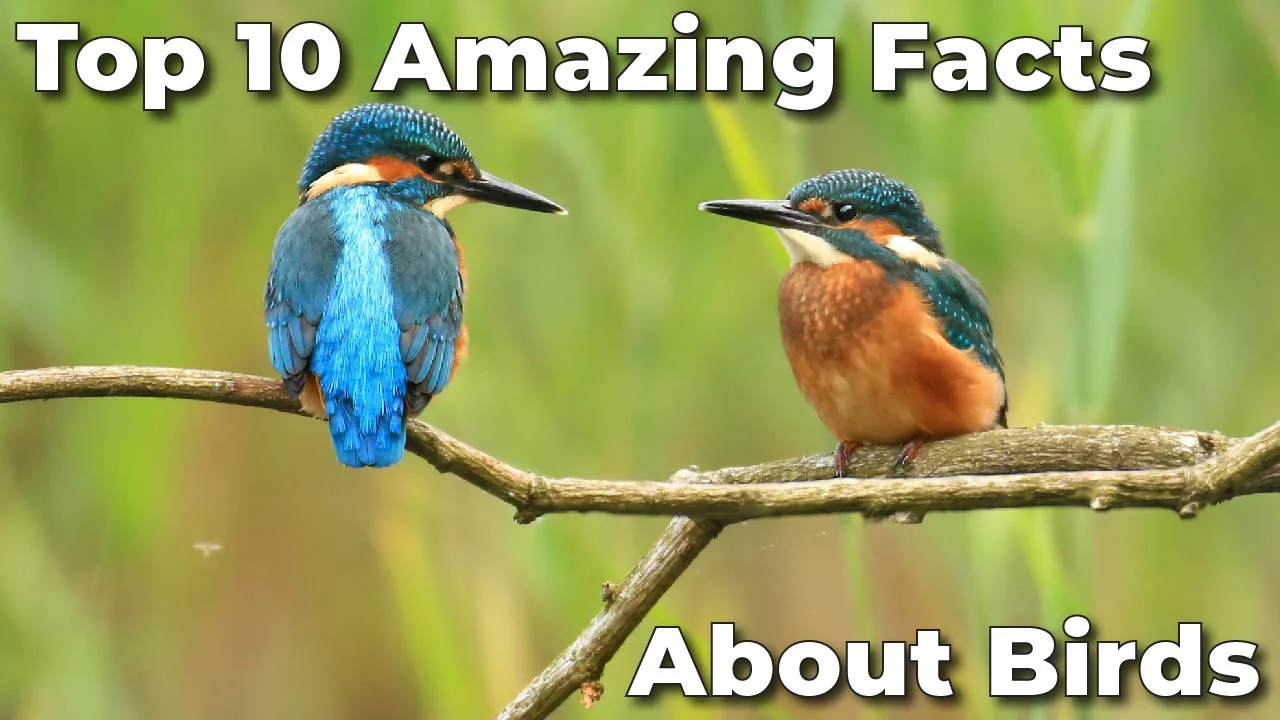Birds have fascinated humans for centuries with their beauty, diversity, and extraordinary abilities. Whether it’s their melodious songs, striking plumage, or impressive migrations, birds never amaze us. But why exactly do birds captivate us so much? Let’s learn the Top 10 Amazing Facts About Birds.
Birds Are Descendants of Dinosaurs
Evolutionary Link to Theropods
Did you know that birds came from dinosaurs? They evolved from theropods, just like the T. rex. Fossils show how feathered dinosaurs turned into birds. Many theropods had feathers to stay warm or show off. Over millions of years, these dinosaurs got lighter bones and changed limbs to fly. That’s how the first birds were born.
Archaeopteryx: The First Bird
Archaeopteryx is often called the first bird. It shows how dinosaurs changed into birds. This creature had teeth like reptiles and feathers like birds. Fossils of Archaeopteryx found in the late 19th century proved evolution. It had a long bony tail and wings, showing it was a mix of dinosaurs and birds.
Birds Have Hollow Bones
Adaptation for Flight
One of the birds’ most remarkable adaptations for flight is their hollow bones. Bird bones are lightweight and very strong. This helps birds fly quickly. Hollow bones make their bodies lighter but still firm. Because they are light, birds use less energy to fly. To stay in the air, they don’t require as much physical strength.
Structural Strength Despite Lightness
Despite being hollow, bird bones have a unique structure that provides exceptional strength. Bird bones are light and robust. They are a great example of nature’s fantastic design. Inside the bones are tiny struts that make them strong but still light. This clever design helps birds handle flying, taking off, landing, and turning.
Some Birds Can Mimic Human Speech
Parrots: The Masters of Mimicry
Parrots are perhaps the most famous mimics in the bird world. They can imitate human speech and other sounds with impressive accuracy. This ability stems from their highly developed vocal apparatus and social nature. Parrots have a particular part of the brain that helps them learn sounds. They can copy many sounds they hear. Parrots don’t just mimic human speech. They can also copy other animals, noises from nature, and even machine sounds.
Other Mimicking Birds
For them to stay in the air, less muscle effort is required.. Lyrebirds can copy many sounds, like chainsaws and camera shutters. This shows how excellent their listening skills are. This remarkable ability serves multiple purposes, from attracting mates to preventing potential threats. The superb lyrebird sings for many minutes. This helps it find a mate.
Birds Have Excellent Vision
Range and Depth Perception
Birds are known for their exceptional vision. Birds have a comprehensive view and excellent depth perception. This helps them fly and hunt well. Eyes on the sides of the head are familiar in birds. This lets them see a lot and spot predators and prey. Predatory birds like hawks and eagles have eyes at the front. This gives them binocular vision, helping them judge distances accurately.
Color Vision Beyond Human Capability
Birds can see a broader spectrum of colours than humans, including ultraviolet light. This enhanced colour vision is crucial in finding food, choosing mates, and avoiding predators. For example, many birds have plumage patterns only visible in the UV spectrum, which they use to communicate and attract partners. Some fruits and flowers also have UV markings that help birds identify them as food sources.
Migration Marvels
Longest Migrations
Bird migrations are one of nature’s most incredible phenomena. Arctic Terns travel thousands of miles yearly from the Arctic to the Antarctic. They travel farther than any other animal. This shows how strong and intelligent they are at finding their way. They have two summers yearly, giving them lots of time in good feeding spots.
Navigation Skills
Birds are good at finding their way. They use Earth’s magnetic field, the sun, and the stars. Some birds even have an inner compass to help them on their long trips. Scientists think birds can feel magnetic fields with special cells in their eyes or beaks. This allows them to find their way even when they can’t see. Birds also know landmarks and use smells to guide them. Their migrations are one of the most incredible things animals can do.
Unique Mating Rituals
Dancing Birds
Many birds engage in elaborate courtship displays to attract mates. Birds of paradise do fancy dances to impress mates. They show off their bright feathers and extraordinary moves. These dances come with sounds and other actions to win over partners. How they show off for mates is super important in the bird world.
Elaborate Nest Building
Nest building is another aspect of avian courtship. Some birds build fancy nests to impress mates. They show how good they are at building and keeping babies safe. Bowerbirds, for example, make nests that are like art. They use colourful things to decorate their nests and catch the eye of female birds. The quality and creativity of the nest play a significant role in the female’s choice of mate.
Birds Have Different Beaks for Different Needs
Specialized Feeding
Birds’ beaks are specially adapted to their feeding habits. The long, narrow beaks of hummingbirds are used to sip nectar. Hawks have sharp, curved beaks for tearing meat. Each beak fits the bird’s diet and how it eats, helping them get food. This shows how birds change over time to fit where they live and what they eat.
Examples of Beak Adaptations
Other examples include the pelican’s pouch-like beak for catching fish and the woodpecker’s chisel-like beak for drilling into wood. These adaptations highlight the incredible diversity of birds and their ecological niches. Finches on the Galápagos Islands have different beaks when eating other foods. This shows how animals change to fit where they live and what they eat.
Some Birds Are Flightless
The Majestic Ostrich
Not all birds can fly. The ostrich is the most enormous bird alive. It can’t fly, but it runs super fast and has strong legs that can give a big kick. Ostriches are the largest bird that can run up to 45 miles per hour, using their strong legs to escape predators. Their large size and inability to fly are adaptations to life on open plains where speed is more crucial than flight.
Penguins: The Aquatic Birds
Penguins are another group of flightless birds adapted for life in the water. They are good swimmers because their wings have evolved into flippers. Penguins swim fast with flippers to catch fish and escape enemies. Their smooth bodies and heavy bones help them dive deep underwater.
Birds Play Key Roles in Ecosystems
Pollination and Seed Dispersal
Birds are vital to ecosystems, performing essential services like pollination and seed dispersal. Hummingbirds pollinate flowers when they drink nectar. Other birds help plants grow by eating fruits and spreading seeds in different places. This allows plants to make more plants and spread to new places. It keeps nature diverse and healthy.
Pest Control
Birds also help control pest populations. Birds eat bugs like mosquitoes and pests on farms. This allows farmers because they don’t need as many chemicals to kill pests. Birds also eat small animals, keeping nature in balance and crops safe. Barn owls and hawks are good at controlling mice and rats on farms.
Birds Communicate in Various Ways
Songs and Calls
Bird communication is a fascinating subject. Birds use songs and calls to attract mates, defend territories, and warn of predators. Every species has a distinct range of sounds. These vocalizations are often complex and can convey a wide range of information. Songbirds sing complex songs that are different for each bird and group. They use these songs to recognize each other and to show who’s boss.
Visual Signals
In addition to vocalizations, birds use visual signals, such as plumage displays and body postures, to convey messages. These visual cues are crucial during mating and social interactions. For example, the bright plumage of a male peacock and its elaborate tail display attract females and deter rivals. Similarly, subtle posture and feather position changes can signal aggression or submission in social hierarchies.
Conclusion
Birds are remarkable creatures with adaptations and behaviours that amaze us. From their dinosaur ancestry to their role in ecosystems, birds are integral to our natural world. Appreciating and protecting these incredible animals is essential for maintaining the balance of our environment.
FAQs: Top 10 Amazing Facts About Birds
A. Birds like parrots mimic human speech due to their social nature and the desire to bond with their caretakers. This mimicry is also a form of vocal learning.
A. Birds navigate by combining the sun, stars, and Earth’s magnetic field. Some species also use visual landmarks and their sense of smell.
A. Habitat loss, climate change, and pollution threaten bird populations significantly. Additionally, hunting and predation by invasive species also pose risks.
A. Birds contribute by pollinating plants, dispersing seeds, and controlling insect populations. These activities help maintain ecological balance.
A. Some birds evolved to be flightless due to the absence of predators in their habitats, allowing them to thrive without needing flight. Adaptations like solid legs for running or swimming have helped them survive. Q. Why do some birds mimic human speech?
Q. How do birds navigate during migration?
Q. What are the main threats to bird populations?
Q. How do birds contribute to ecosystems?
Q. Why are some birds flightless?

